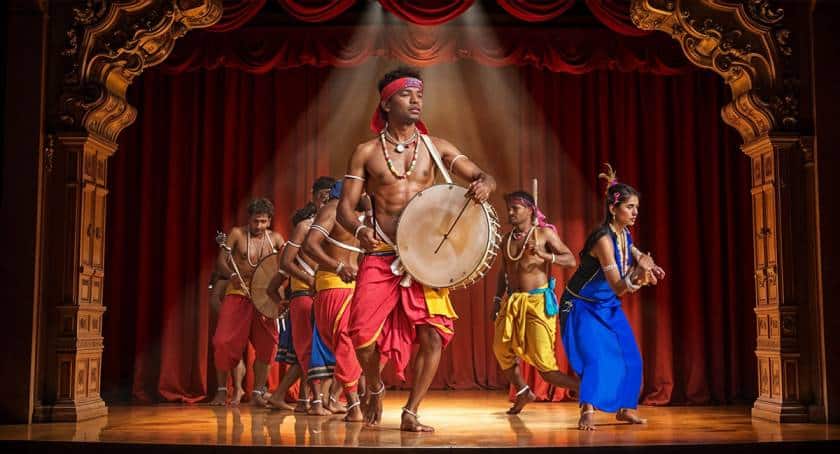Dhap Dance: Rhythmic Folk Dance of Odisha’s Tribals
Dhap Dance is a mesmerizing folk dance from the eastern Indian state of Odisha, deeply rooted in the region’s rich cultural traditions. The tribal communities favor and perform this art form enthusiastically and passionately. Characterized by rhythmic movements, energetic performances, and traditional music, Dhap Dance is more than just an artistic expression—it celebrates life, nature, and social bonding. With its origins steeped in tribal customs and folklore, Dhap Dance thrives as a symbol of Odisha’s indigenous heritage. This article will examine this fascinating dance form’s history, significance, performance style, costumes, and influence.
Origins and History of Dhap Dance
It traces its roots back to the indigenous groups of Odisha, particularly the Kandha community. This dance form has been performed for centuries, marking various festivals, rituals, and celebrations within tribal communities. The name ‘Dhap’ comes from the instrument central to the performance—a large percussion instrument that provides the rhythmic beat essential to the dance.
Traditionally, the Dhap Dance was performed during:
- Harvest Festivals – As an offering of gratitude for a bountiful harvest.
- Weddings and Social Gatherings – To enhance the joyous spirit of community celebrations.
- Religious and Ritualistic Ceremonies – Seeking blessings from deities and local spirits.
Over time, Dhap Dance has evolved from being a tribal ritual to a recognized cultural performance, often showcased at state and national festivals. It continues to be a living tradition that binds generations together and strengthens cultural identity.
Significance of Dhap Dance
Dhap Dance holds immense cultural and social significance among the tribal communities of Odisha. It serves as a vibrant medium of expression, allowing performers to convey emotions of joy, devotion, and unity. Some of the key aspects of its significance include:
- Celebration of Nature: The groups closely tie the dance to their agrarian lifestyle.. It expresses gratitude to nature and celebrates the changing seasons and agricultural prosperity.
- Religious and Ritualistic Importance: Many performances of Dhap Dance are dedicated to deities and local spirits to seek divine blessings for happiness and prosperity. It often accompanies religious rituals, connecting the spiritual and cultural lives of the community.
- Social Bonding and Unity: It fosters community participation and strengthens ties among villagers. The performance’s collective nature encourages interaction, cooperation, and unity among people of all ages.
- Preservation of Tribal Heritage: As a traditional art form, Dhap Dance is crucial in keeping tribal culture alive. By passing down the dance through generations, communities ensure that their customs and artistic expressions continue to thrive.
Performance Style and Movements
The Dhap Dance is typically performed by groups, with participation from individuals of all genders engaging in synchronized movements. The dance involves a combination of:
- Rhythmic Steps: Dancers move in circular formations, skillfully matching their steps to the beats of the Dhap drum. The rhythmic footwork creates a dynamic visual spectacle.
- Expressive Hand Gestures: Hand movements are integral to the dance and often depict emotions such as joy, devotion, and elements from tribal folklore. These movements improve the performance’s storytelling element.
- Energetic Spins and Jumps: The dance incorporates energetic spins, jumps, and rapid movements, contributing to its lively and celebratory atmosphere.
- Coordination with Music: The beats of the Dhap drum dictate the pace and flow of the dance. Variations in tempo introduce dramatic effects, making the performance engaging and vibrant.
Music and Instruments
Music forms the heartbeat of Dhap Dance, and traditional instruments accompany live performances to enhance the rhythmic experience. The primary instrument used is:
- The Dhap Drum
The Dhap drum is a large, round, double-headed percussion instrument made of wood and animal hide. People play it by hand. Its deep, resonating sounds guide the dancers’ movements and set the tempo for the performance.
- Additional Musical Instruments
In some performances, other traditional instruments accompany the Dhap drum, including:
- Mahuri – A wind instrument similar to a flute, adding a melodic layer to the music.
- Changu – A little drum that enhances the performance’s rhythmic underpinnings.
Traditional Attire and Costumes
The vibrant costumes worn during the Dhap Dance reflect Odisha’s tribal heritage. These traditional outfits add to the visual appeal of the performance.
For Men:
- Colorful dhotis and turbans.
- Beaded necklaces and silver ornaments.
- Sometimes, individuals drape a decorative sash or shawl over their shoulders.
For Women:
- Vibrant sarees with traditional tribal designs.
- Heavy jewelry, including bangles, earrings, and anklets.
- Floral headpieces or accessories that enhance the aesthetic appeal.
The elaborate costumes elevate the beauty of the dance and highlight the artistic sensibilities of Odisha’s tribal communities.
Occasions and Celebrations
Dhap Dance is performed on a variety of special occasions, including:
- Karam Festival: Dedicated to the Karam deity, this festival celebrates nature, agriculture, and fertility. It is a central part of the festivities, performed with devotion and enthusiasm.
- Chaitra Parva: Marking the beginning of a new season, Chaitra Parva is an essential tribal festival where Dhap Dance plays a crucial role in the celebrations.
- Weddings and Social Gatherings: It is an essential feature of tribal weddings and community events, adding a joyful spirit.
In modern times, the dance is also showcased at cultural fairs, tourism events, and national folk festivals, helping it gain wider recognition across India.
Final Thoughts
It is a lively manifestation of Odisha’s tribal heritage and goes beyond simple traditional performances. A vital component of India’s creative landscape, this folk dance is known for its powerful movements, rhythmic beats, and cultural significance.
As cultural enthusiasts and organizations continue to preserve and promote Dhap Dance, future generations will keep this age-old art form thriving. Whether performed in remote tribal villages or on grand festival stages, the Dhap Dance symbolizes unity, joy, and artistic brilliance. It is evidence of the enduring cultural legacy of Odisha’s indigenous communities, keeping their rich traditions alive for the world to witness and appreciate.


